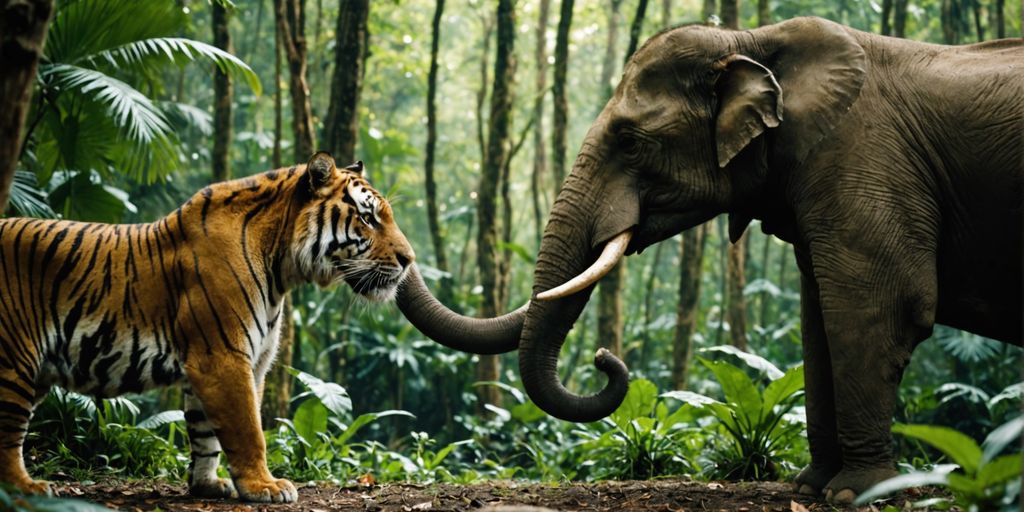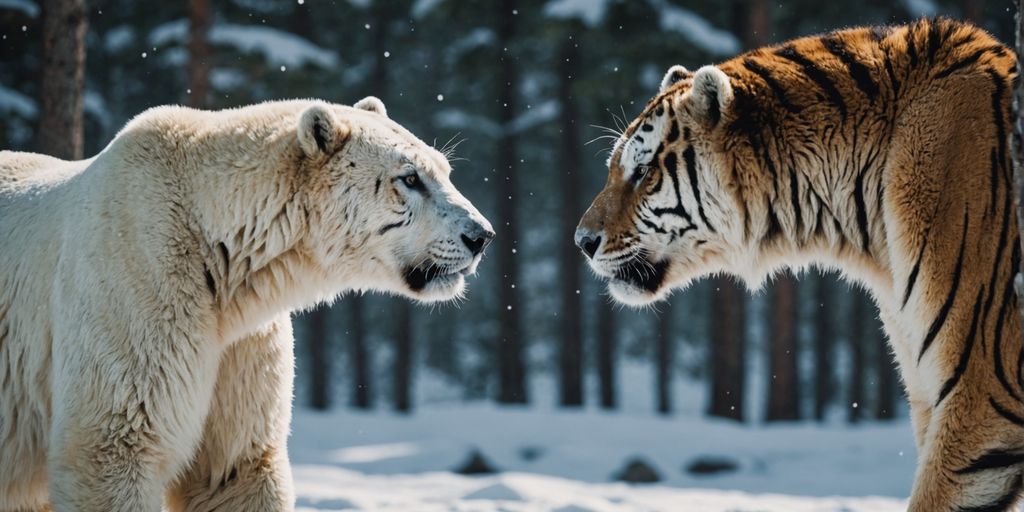Your Cart is Empty
🙏HELP US SAVE TIGERS!🐅 WE DONATE 1% OF OUR SALES TO WILDLIFE ORGANIZATIONS ( WWF ...)
Menu

🙏HELP US SAVE TIGERS!🐅 WE DONATE 1% OF OUR SALES TO WILDLIFE ORGANIZATIONS ( WWF ...)
Where does the Tiger Live?
May 28, 2021 7 min read

Nowadays, the Tiger has become a true symbol of natural power. But as mysterious as it may seem, there are still too many misunderstandings about the big cat. So much so that it is not uncommon to see people mistaken about its location. Because the Tiger is not a simple wild cat found everywhere on earth, its natural habitat, although very varied, depends on certain factors.
Of course, we will not discuss the subject of Tigers in captivity, which can be found anywhere on earth. Animal parks and zoos worldwide have them so that today there are more Tigers in captivity than in the wild. It is, therefore, much more fascinating for us to tell you about the habitat of the Tiger in its natural environment.
Even if its population has dropped mainly in the last few centuries, the striped Tiger continues to exist on the lands of many countries. But the vast territory it once inhabited is not the same nowadays. So much so that it now occupies small patches of land and can even live in the same region as the local population. When we know what the man-eater can do to people who encroach on its land, we quickly realize the problem that this cohabitation poses.
Despite all these things, the Tiger belongs above all to a single continent. This same continent made him discover the world to become the legendary animal we know today. With this article, we invite you to find the lands of origin of the Tiger and the environments and the countries the most adapted to its survival.
Asia: A territory specific to the Tiger

Tigers are native to the Asian continent and historically were widespread from the Caucasus through Indonesia to Siberia, populating most of Asia and the Indian subcontinent. However, their range has shrunk considerably in just one century. Therefore, this big cat is an endemic animal to the Asian territory and is not found anywhere else. It does not exist and has never lived in the wild on African lands. The Lion is the King of Africa; on the other hand, the Tiger is the Emperor of Asia!
At present, the Tiger is only found in Southeast Asia, India, some Russian regions, and Western China. In short, it is an Asian animal, found only in 13 or 14 countries, including China, India, Indonesia, Bangladesh, Bhutan, Laos, Malaysia, Cambodia, Burma, Russia, Thailand, Vietnam, Nepal, and possibly North Korea.
In the last century, two species of tigers disappeared from the lands of 2 Indonesian islands. The Java Tiger and the Bali Tiger have vanished from the globe's surface. So that there are only one species of Tiger left in Indonesia, it is found on the island of Sumatra. Some fossils suggest that the felid would have also lived in Borneo and Palawan, in the Philippines.
Honor these extinct felines with our Tiger Paintings! ⤵️
Tigers can adapt to different environments ranging from the Siberian taiga to the Indian savannahs, through the tropical mangroves of Indochina. This versatility is explained by an excellent adaptation capacity in this fearsome carnivore and results in rapid evolution between subspecies. By living in territories with sometimes opposite climates, the organism of these animals has been transformed over time to maximize the species' chances of survival.
Siberian Tigers, for example, thrive in Russia's cold, sometimes snow-covered forests, which explains why their fur is slightly thicker than other subspecies. On the other hand, some Tigers found in Southeast Asia, such as the Sumatran Tiger, the smallest subspecies, have smaller measurements.
We'll now look at the Tiger's most desirable conditions. There aren't often places where Tigers can be found in large numbers. However, if we ignore the human aspect, they are ideal habitats for their survival. For the second portion, we don't consider poaching or habitat degradation. However, without man's intervention, the areas should be as they should be.
Fawn Inhabited Areas
1) Prerequisites for the life of the Tiger

Above all, even if the habitats of the Tiger may vary between each subspecies, they must have certain essential elements such as
PROXIMITY TO A WATER SOURCE

The Tiger needs water to stay hydrated but not only. They also use these water sources to stalk prey that would like to refresh themselves by drinking from the source. Tigers are strong swimmers, which sometimes allows them to drag their victims in the water.
AN ABUNDANCE OF PREY

Tigers need access to prey to survive. A large part of their diet consists of ungulates. These herbivores are large mammals and represent an enormous amount of food for the Tiger. When we know the food needs of the beast, we immediately understand that territory without the presence of these large animals can not shelter the Tiger.
If you want to learn more about tigers, including their weight, make sure to check out How much does a tiger weigh on Tiger Universe.
A DENSE VEGETATION

This condition is essential because the Tiger watches for its prey while hidden in the tall grass. Its stripes are designed to allow it to camouflage itself within the vegetation. The Tiger does not have enough stamina to exhaust its target; stealth attacks are the only way to succeed in its hunt. Therefore, its environment must be beneficial to it to evolve at all discretion.
2) The Indian Savanna

India is a land of welcome for many animal species; it is the only territory in the world where Tigers and Lions cohabit. India is a Tiger country, especially thanks to its climate and its very favorable vegetation. The Indian savannahs are made up of high golden grasses in which the Tiger becomes invisible thanks to its striped coat!
The Bengal Tiger is the species of Tiger living on the Indian territory; it is also the basic species of the striped fawn. This means that it is from this species that all other subspecies of Tigers came from. The Indian territory represents in a way the ancestral lands of the Tiger. It is not for nothing that the population of Bengal Tigers is the largest in the world within this country.
The vegetation is dense, the water sources sufficient, but above all, the variety of prey is phenomenal! The Tiger is a large carnivore that needs large animals to sustain itself. India is home to animals such as the chital, the sambar, the buffalo, the elephant, and even the rhinoceros. A wide range of prey is available to this nocturnal hunter, so the Indian government aims to make the country a sanctuary of animal diversity.
The hunting territory of this striped beast extends over India, although it is fragmented into reserves. Thus, even if the savannah is the preferred environment of the Tiger, it is also present in the Sundarbans province in the heart of the mangroves. It also inhabits some tropical forests and rainforests juxtaposed with grasslands to drink in quantity. There are many safaris in India where tourists can observe the Tiger.
3) The Siberian Tiger

The boreal forests of deepest Russia are a luxury habitat for the Siberian Tiger. Indeed, these remote woods offer calm and serenity to the Tiger in addition to a great diversity of prey to hunt. However, the extreme climatic conditions of this environment have forced it to evolve. Thus, this subspecies has an enormous fur in strategic areas, which protects it from snow and cold. In this way, the legs and neck of this big snowcat are covered with long hair.
However, despite all these elements in favor of the Siberian Tiger, the world population of this feline is greatly threatened. They are making the animal an endangered species. Once again, Man is the only one responsible for this catastrophe by massacring its habitat. Indeed, illegal trade and deforestation are the two reasons that cause the extinction of these felids. Even if the forest guards do their best to fight against poaching, the means are not sufficient to keep viable wildlife.
Despite this sad event, the dense forests of Russia and especially those of the Amur region remain a home for the Siberian Tiger. The Siberian Tiger is a perfect example of its impressive ability to adapt. No one could have predicted before its discovery that the Tiger would be able to live in a territory where temperatures are around -20 degrees. He is so used to South Asia's warm and sunny regions!
4) The Indonesian Islands

Even if Indonesia knew the extinction of its three species of Tigers, the climate of these islands was, however, perfectly adapted to its proliferation. Indeed, the Indonesian Tigers lived at the foot of the mountains and in low-altitude forests. Thanks to the hills, these felids could drink in all tranquillity in the rivers and hunt for deer. Moreover, at that time, the center of the islands was absent of human presence because Men preferred to settle on the coasts.
Unfortunately, the demographic explosion of the Indonesian archipelago will be the reason for the Great Tiger. I need to feed a growing population, the islands' interior began to be transformed into agricultural land, and plantations invaded the territory of the solitary feline. This change irrevocably led to the destruction of its habitat, forcing it to live in smaller and smaller parts. The Sumatran tiger is the only species to have emerged from this intensive agricultural policy alive.
These Indonesian islands were wildlife paradises. They show that the tiger had no problem evolving in territories surrounded by water. The adaptation of these "island tigers" was and continues to be obvious when we look at the Sumatran Tiger. The low presence of large deer has caused them to evolve by reducing their size more and more. This is why they were the three smallest subspecies of Tigers.
To summarize

The Tiger lives in many countries even if its population has decreased mainly in the last decades. It is one of the animals adapting most easily to an environment thanks to its versatility. This characteristic allows it to populate diverse regions with almost opposite climates. Nevertheless, the Tiger was born in Asia and existed only on the Asian continent in the wild.
Therefore, the African Tiger is a common misconception that continues to persist today. However, the big cat can be found in some African reserves, but it was imported from Asia. The Tiger will always prefer the hot and humid climate of the Indian savannah. But nothing prevents it from living in the snowy forests of Russia or the mountainous woods of the Indonesian islands.
However, if one thing is sure, it is that no matter where the Tiger lives, it is in great danger. Because the environment is not everything in this world, human actions can lead to permanent disappearance. In this way, we can see that the Tiger's range is in free fall in the countries where it lives. More globally, it seems that poachers and human activity primarily threaten wildlife. We must remedy this very quickly if we want to preserve this unique species that is the Tiger!
Make a gesture for the planet with our 100% ecological wooden Tiger Watches! ⤵️
Also in Tiger Blog

Sloth Bear vs Tiger: Who Would Win?
July 13, 2024 7 min read
Explore the thrilling showdown between a sloth bear and a tiger, analyzing their strengths, behaviors, and survival tactics.
Read More
Tiger vs Elephant: Who Reigns Supreme in the Animal Kingdom?
July 13, 2024 7 min read
Explore why elephants usually triumph over tigers in the wild, highlighting their size, strength, and defensive prowess.
Read More
Epic Battle: Polar Bear vs Tiger, who win?
July 11, 2024 8 min read
Epic showdown: Polar Bear vs Tiger. Discover who would win in this thrilling battle of nature's fiercest predators.
Read More
